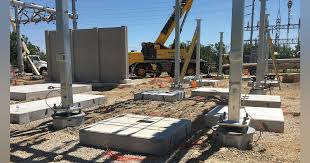Foundations are the unseen backbone of every robust infrastructure project, yet traditional cast-in-place methods often leave contractors grappling with delays, inconsistencies, and escalating costs. In modern construction, innovative solutions are crucial to overcome these challenges. Precast pole bases have emerged as a powerful alternative, combining precision manufacturing with rapid installation techniques to deliver unmatched stability and performance.
By addressing the shortcomings of conventional methods, these engineered bases ensure consistent quality, weather-resilient installations, and significant time and cost savings. This breakthrough approach transforms how municipalities, utility companies, and developers think about building durable, reliable structures that stand the test of time. By rethinking the way foundations are built, precast light pole bases are quickly proving to be the future of resilient construction.
In this blog, we will explore what are precast pole bases, discuss their advantages, examine their applications in modern infrastructure, and walk you through a step-by-step installation guide to illustrate how they revolutionize foundation solutions.
What Are Precast Pole Bases?
Precast pole bases are concrete foundations manufactured in advance and fully cured in factory settings. These bases are designed to secure utility poles, streetlights, and comparable structures, providing uniform quality and increased durability. Arriving prepared for installation, these bases remove the need for on-site pouring and curing, decreasing labor expenses and delays caused by weather conditions.
Advantages of Precast Pole Bases
Switching to precast pole bases offers numerous benefits that address the inherent problems of traditional foundations. Let’s explore these advantages in detail.
- Speed and Efficiency
One of the most compelling reasons to choose precast bases is the significant reduction in installation time.
- Faster Deployment: Precast bases arrive ready for installation, eliminating the need for on-site concrete mixing and curing. This can reduce installation time from days to mere hours.
- Streamlined Workflow: Projects that once faced weather-related delays can now adhere to stricter schedules, keeping everything on track.
- Project Management Benefits: Contractors can manage timelines more predictably, reducing the need for contingency planning and last-minute adjustments.
- Superior Quality and Durability
Precast bases are manufactured under strict quality controls, ensuring consistency that is hard to match with on-site methods.
- High-Strength Materials: The concrete used in precast bases is often higher, providing enhanced load-bearing capacity.
- Controlled Environment: Factory conditions mean that every base is made with the same precision, reducing the risk of defects.
- Enhanced Longevity: With built-in reinforcements and controlled curing processes, precast bases have a longer lifespan, translating into lower maintenance costs.
- Weather Independence and Reliability
Weather conditions have long been the bane of construction schedules, but precast bases offer a robust solution.
- Uninterrupted Progress: Since the bases are pre-cured, rain or snow does not interfere with installation.
- Year-Round Application: Precast bases can be installed without concern for adverse weather conditions, whether it’s the heat of summer or the chill of winter.
- Reduced Risk of Material Compromise: Pre-manufactured bases avoid the common pitfalls of on-site curing, such as uneven strength distribution and shrinkage cracks.
- Cost Efficiency and Safety
While the initial cost of precast bases may appear higher, the long-term savings are considerable.
- Lower Labor Costs: A simplified installation process requires fewer workers, and on-site labor is minimized.
- Reduced Equipment Needs: Eliminating on-site mixing and curing equipment further cuts costs.
- Safety Enhancements: Less on-site work means fewer risks associated with heavy machinery and manual labor, reducing the potential for workplace accidents.
Applications of Precast Pole Bases in Modern Infrastructure
- Renewable Energy Applications
The renewable energy industry is rapidly evolving, and strong foundations are essential to support emerging technologies.
- Solar Panel Mounting: Precast bases can provide a stable platform for solar panels, ensuring optimal alignment and durability.
- Wind Turbines: For smaller-scale wind projects, the enhanced stability of precast bases is ideal for securing turbine poles.
- Eco-Friendly Installations: The controlled production environment for precast bases often means less material waste, aligning with sustainable construction practices.
- Utility and Communication Poles
For utility companies and telecom providers, the reliability of their infrastructure is non-negotiable.
- 5G Towers and Beyond: As demand for high-speed internet grows, precast bases deploy new towers, ensuring continuous service quickly.
- Power Distribution: Utility poles for electricity distribution benefit from precast foundations’ enhanced stability and load-bearing capabilities.
- Efficient Network Expansion: The rapid installation of precast bases allows for quicker network expansions, more effectively meeting consumer demand.
- Future Smart Infrastructure and IoT
As our cities become more competent, the infrastructure supporting them must also evolve. Precast pole bases are leading the way for next-generation installations.
- Integrated Sensors: Future designs may include smart sensors embedded within the bases to monitor structural integrity and environmental conditions.
- Data-Driven Maintenance: Real-time monitoring can predict maintenance needs, reducing downtime and prolonging the lifespan of the infrastructure.
- IoT Connectivity: With the rise of the Internet of Things, having a reliable and stable foundation is crucial for seamlessly integrating various innovative technologies.
- Streetlights and Urban Infrastructure
Street Lighting is essential for public safety and urban aesthetics. Precast bases provide a stable and durable foundation that:
- Improves Safety: Consistent, reliable foundations ensure that streetlights remain upright and functional.
- Enhances Urban Planning: Faster installations mean cities can upgrade or expand their lighting infrastructure without prolonged disruptions.
- Reduces Maintenance: With fewer foundation-related issues, municipalities can allocate resources to other urban development areas.
Precast Pole Base Installation: A Step-by-Step Guide
Switching to precast bases is not just about the benefits, it also simplifies the installation process. Here’s a detailed look at how these foundations are installed:
- Pre-Installation Planning and Site Preparation
A successful installation starts well before the precast bases are delivered to the site.
- Site Survey: Engineers assess the location to determine the optimal placement for each base.
- Marking and Excavation: Once the locations are finalized, markings are made on the ground, and precise excavation begins. The holes must be dug to the exact dimensions required by the precast design.
- Foundation Layout: Careful planning ensures that the spacing and alignment meet project specifications, preparing the ground for the bases to be set perfectly.
- Delivery, Placement, and Securement
Once the site is prepared, attention turns to placing the precast bases in their designated spots.
- Transportation: Precast bases are manufactured off-site and delivered using specialized trucks to handle heavy loads.
- Placement: The bases are lifted and precisely placed into the pre-dug holes using cranes or other heavy machinery.
- Securement: Once positioned, the bases are secured by backfilling the holes with gravel or soil. This process stabilizes the base and ensures it will not shift over time.
- Final Adjustments and Post-Installation Procedures
The final stage is all about making sure everything is in perfect order.
- Pole Installation: With the base secured, poles are mounted using pre-installed anchor bolts. Thanks to the precision-engineered features of the precast bases, this step is straightforward.
- Electrical and Conduit Connections: Any electrical wiring or conduits are connected during this phase for projects involving streetlights or communication poles.
- Site Cleanup and Inspection: The area is cleared of debris, and a final inspection is conducted to ensure the installation meets all specifications and safety standards.
Final Thoughts
Precast pole bases offer an innovative, efficient solution to foundation challenges, saving time, reducing labor costs, and ensuring durability. Their quick installation and minimal site disruption make them ideal for contractors seeking reliable results. Plus, their consistent quality and eco-friendly production make them a sustainable option for modern projects. With the addition of accessories like adjustable base plates and anchoring systems, precast pole bases provide even more flexibility and ease of installation. Choosing precast pole bases streamlines your workflow and builds stronger, longer-lasting foundations, proving that innovation and efficiency can go hand in hand.




